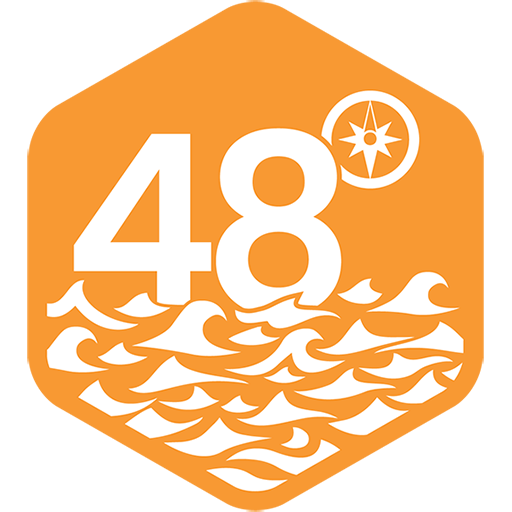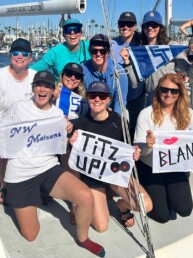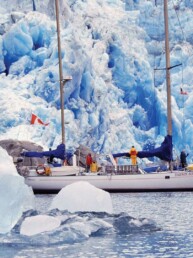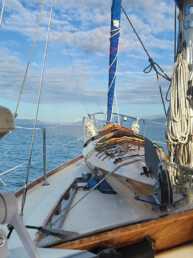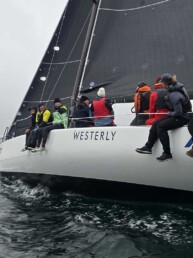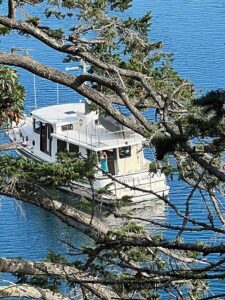
With seven round trips to Alaska and oodles of other Salish Sea and Inside Passage cruising on both their Valiant 40, Aurora, and now their Nordic Tug 37, Morning Light, Carol and Jack have an enviable library of sea stories. But sometimes, the best cruises don’t make for wild tales. What they do provide, though, is the restorative, transformative, and invigorating slice of boat life so many of us seek when casting off. Here is one such tale from this pair of well-traveled cruisers enjoying their home waters in a mode of easy-going exploration.
After a couple of days recovering from the exhilaration and exhaustion that the Wooden Boat Festival brings, we headed north to the San Juan Islands on flat water from our homeport of Port Townsend. A mere five hours later, we anchored Morning Light, our Nordic Tug 37, in a little nook in Reid Harbor with noisy kingfishers, a patient heron standing on one leg, and vultures soaring on the thermals. Jack figured that the late summer drought had left some carrion on the golden grass among the madrone and fir trees. This is what we wanted. We were close enough to the border to be without reliable internet access, but weren’t rocking and rolling like we would have been on Sucia, Matia, or Patos.
We sat down with our books, interrupted only by food. Finally, I could dig into boatbuilder Diana Talley’s memoir, “Center of Buoyancy.” After a while, I launched my paddleboard while Jack, who lives with a spinal cord injury, worked out in his makeshift gym in the cockpit.
Before paddling away, I noticed that the green growth at Morning Light’s waterline was not so bad, but I could see that the undersides of the rub rails needed cleaning. I deployed the fenders to have something to hold onto and scrubbed away before making my way to the beach for a hike.
I took the steps up through the woods to the top of the hill above Morning Light, before walking over to Prevost Harbor. Across the water at one of Stuart Island’s permanent settlements, a boat was unloading supplies. Year-round island residents are rugged folks. They manage their own electricity, water supply, sanitation (including charming outhouses that are grandfathered into the San Juan County codes), and homeschooling because there are not enough kids to keep the schoolhouse open. Eventually, I found a trail that led back to the south end of the park, where Jack was still working out in the cockpit.
As the moon rose one evening, M/V Westward dropped anchor next to a sister restored yacht, Catalyst. When they’re not cruising north in summers (where we’ve encountered both frequently) or south in winter, these ships spend time in Port Townsend, proudly exhibiting the craft of our local shipwrights.
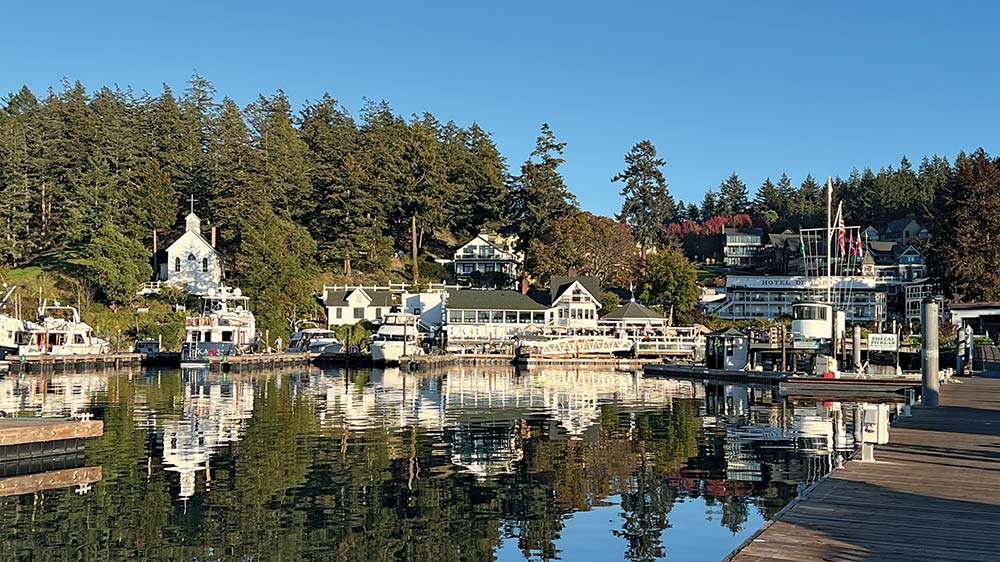
Roche Harbor
For an utter change of scenery, we crossed Spieden Channel to Roche Harbor on San Juan Island for a couple of nights. Roche was a memorable stop on our first ever cruise north so many years ago. The historic company town from the 1860s has been spiffed up into a real resort, but it’s still a place where traditions remain mostly intact. As we docked in front of the chapel, the carillon rang out traditional tunes to mark the noon hour.
The guest moorage space was quite empty and offered unbroken views. We stepped off the boat to explore the headquarters of San Juan Island’s prosperous lime trade, which contributed to the building of towns from here to San Francisco. We walked among the U.S. and Canadian flags that line the docks and walkways, remembering the ceremony that concludes every day at Roche Harbor.
The bar off the formal dining room where locals and regulars gather was, happily, roll-in accessible via the yellow brick road in front of Hotel de Haro. We found a table with the perfect view. The first night it was drinks and then a walk, the second was a walk followed by drinks and a light meal—all at the same perfect table.
Sunset in Roche Harbor is always impressive. We watched the dock crews remove the American and Canadian flags from the wharves, paths, and roof of the company store. Then, “God Save the King” and “O Canada” were played as the British and Canadian flags were lowered from the yardarm. Standing at attention along with the resort staff were the crews of visiting boats, including a US Coast Guard vessel that had stopped by to refuel. Anyone who had not been paying attention now was. In the silence, a bugler played “Taps” as the United States flag was lowered and furled against the setting sun.
Re-tethered to the internet, I searched for M/V Paspatoo, a wooden yacht that stands out among the plastic behemoths that moor here. Scrolling down its webpage, I discover an appreciation of the Port Townsend shipwrights who restored her. Among the dozens of names are members of Diana Talley’s crew, who she features in her book. Ours is a small, interwoven community, isn’t it?
Jones Island
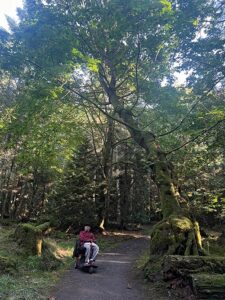
The next day, we departed for Jones Island State Park. Jones serves kayak-campers and accommodates boats in coves on its north and south ends. The north cove has a small dock with a ramp leading to the island. One of the joys of offseason cruising is finding dock space. As we tied up, crews from State Parks, San Juan County, and one of their contractors greeted us. While I reassembled Jack’s scooter next to Morning Light, I thanked them for ensuring Jones Island’s remarkable accessibility and promised to let them know if anything could be improved.
As it turns out, everything was perfect. A smooth path winds through largely old growth forest to the south cove and the accommodations were pristine. The long-drop composting toilets have windows, skylights, and long wooden ramps. The two Adirondack shelters now have concrete floors. We admired the freshly painted green interiors, noting that the bottom sleeping platforms have been set at slightly different heights to better serve a variety of people, including those who use wheelchairs.
Near both the north and south bays are fairly large pavilions with picnic tables and plenty of space around them for pitching tents. Everything must be packed in and out, though well water flows at certain times of the year. Jones Island is a gem of natural beauty, and a thoughtfully executed public resource for all to enjoy.
Blind Bay
From Jones, we headed east through lovely Wasp Passage into Cayou Channel (formerly Harney Channel) wondering when we’d encounter our first ferry. As we neared our destination, the ferry Yakima pulled out of the Shaw Island landing and confused us by turning around before it headed to Orcas Landing across the pass. Most Washington State car ferries alternate bow and stern as they shuttle between two terminals.
The landings on Orcas and Shaw lie very close together across a sliver of sea through which four Washington State Ferry routes pass, sharing the water with kayaks, SUPs, rowboats, recreational and commercial fishing vessels, construction barges, local government and mail boats, and all manner of vacationing sail and power craft. Transiting this passage calls for careful navigation. Though not as large as the B.C. Ferries, the four vessels connecting San Juan County to the mainland range between 310 and 382 feet.
As we settled into our anchorage in Shaw Island’s Blind Bay and the sun sank behind the quiet shoreline foliage, I could count cars through my binoculars—a single vehicle disembarked the ferry on Shaw. Such is life in the islands during the peaceful offseason.
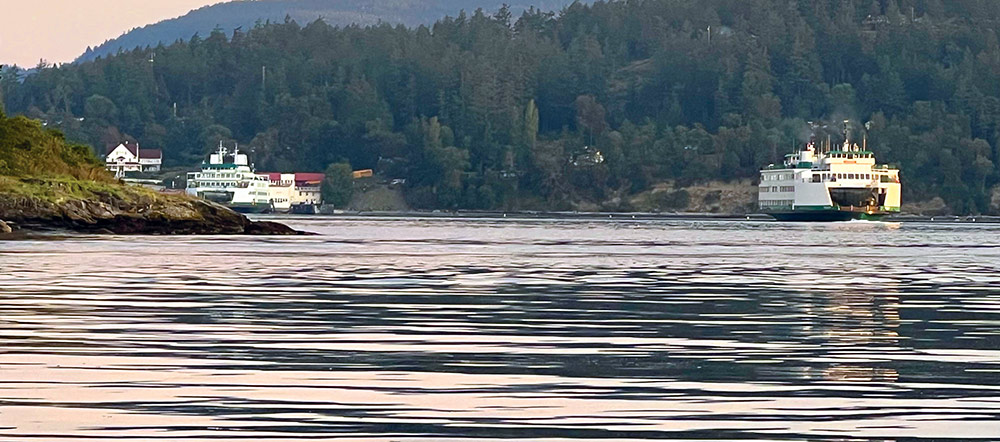
Watmough Bay
Escaping Blind Bay’s rocking and rolling from ferry traffic, we cruised through Thatcher Pass, and continued along the squirrely waters of Rosario Strait. Ahead of us was an enormous oil tanker being escorted by a huge tug headed toward the Strait of Juan de Fuca and the ocean beyond. The Anacortes refinery receives crude oil from Canada’s Trans Mountain pipeline, trains from North Dakota and the Midwest, and tankers from Alaska and beyond. And here was the final product underway. All were reminders of how much fossil fuel is being consumed—including by Morning Light—and how hard it’s going to be to mitigate climate change before it’s too late.
As we motored into exquisite Watmough Bay at the southeast corner of Lopez Island, we watched a dozen turkey vultures soaring high above the cliff that dominates the north side of the bay. We choose one of the three mooring buoys that are provided free of charge by Washington’s Department of Natural Resources. Watmough Bay and its beloved beach where locals gather every afternoon is cooperatively managed by the San Juan County Land Bank, the San Juan Preservation Trust, and the federal Bureau of Land Management.
Sitting on the bow as the boat slowly swung, I bathed in the intermittent warm sun and cool shade. Moments before it disappeared under the horizon, the sun cast a red glow on the rocky mountain ridge that lies in front of Mt. Baker. The perfect views just kept coming, and I thought about how lucky we are to live and cruise here, and to call these watery surroundings our home.
When it was time to leave, we floated away on flat water with less than 5 knots of wind, conditions that would have been disappointing on our Valiant 40, but are most welcome for Morning Light. Soon, though, we encounter fog—a whiteout thick enough to cut with a knife. We set our course on the yellow marker where the shipping lanes from Rosario and Haro straits meet those of Admiralty Inlet and the Strait of Juan de Fuca. We came upon the yellow buoy just in time to slip by and get a close-up of the sea lions hauled out there.
Fortunately, the vessel traffic was light on this busy corridor connecting the Salish Sea with distant ports. Grateful for our AIS transmission signaling Morning Light’s position, we received a request from a commercial ship to pass starboard to starboard, and a call from a sailor who gave his coordinates because his AIS was down. We couldn’t see either of them, nor could we see the Point Wilson lighthouse as we crept past. Less than a mile beyond, however, the fog dissipated just enough for us to make out the chimney of our house.
Over many years, we’ve cruised some of the most wildly remote and unambiguously grand locations in the Pacific Northwest, indeed in the world. We’d never trade any of that experience and will relish the chance to explore those regions again. But here we were, closing out a relaxing little jaunt only miles from home—just as satisfied, just as grateful, just as happy as ever.

Carol McCreary and her spouse, Jack, took up sailing in their 60s. Having recently transitioned from sail to power, they look forward to the bonus years out on the water.
